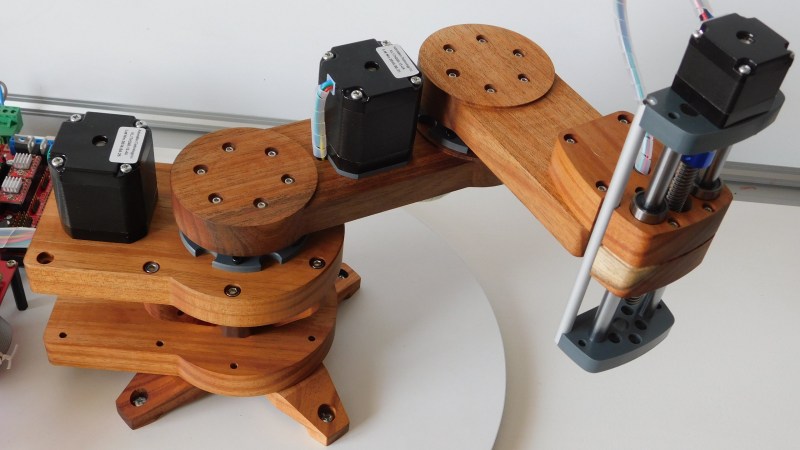[igarrido] has shared a project that’s been in the works for a long time now; a wooden desktop robotic arm, named Virk I. The wood is Australian Blackwood and looks gorgeous. [igarrido] is clear that it is a side project, but has decided to try producing a small run of eight units to try to gauge interest in the design. He has been busy cutting the parts and assembling in his spare time.
Besides the beautifully finished wood, some of the interesting elements include hollow rotary joints, which mean less cable clutter and a much tidier assembly. 3D printer drivers are a common go-to for CNC designs, and the Virk I is no different. The prototype is driven by a RAMPS 1.4 board, but [igarrido] explains that while this does the job for moving the joints, it’s not ideal. To be truly useful, a driver would need to have SCARA kinematic support, which he says that to his knowledge is something no open source 3D printer driver offers. Without such a driver, the software has no concept of how the joints physically relate to one another, which is needed to make unified and coherent movements. As a result, users must control motors and joints individually, instead of being able to direct the arm as a whole to move to specific coordinates. Still, Virk I might be what’s needed to get that development going. A video of some test movements is embedded below, showing how everything works so far.
We do recall another SCARA robot arm project, Evezor, which was brilliantly set up to engrave and stack 400 individually numbered coasters as a proof of function, but whose Kickstarter campaign needed a high goal and was ultimately unsuccessful. [igarrido] has his sights set on a much more attainable set of eight private prototypes, and has a few more specs and a Q&A online should you be interested in joining the development party.

















LinuxCNC and Machinekit support SCARA Kinematics. Machinekit runs on the BeagleBone and there are RAMPS style BoBs for that. https://reprap.org/wiki/CRAMPS
RepRap Morgan used SCARA kinematics, that code should be available.
can you provide the firmware for controll of scara robot?
That is relley nice. Would love to try one of those with a duet3d witch supports scara arms for 3d printing.
Nice design, if you go mechanically more complex you might be able to move a lot of mass towards the stationary base by using concentric shafts and a belt to drive the upper and lower arms (Another belt in the lower arm can also keep a wrist joint pointing in the radial direction). The Z axis can be done by moving the whole arm assembly up and down. Having all that weight out all the way at the end of the arm makes it much harder to get accurate control.
The RepRap Helios does that, if it ever got finished. see https://hackaday.io/project/21355-reprap-helios
Smoothieware has supported SCARA for quite some time. http://smoothieware.org/morgan-scara
Yep Smoothie has supported SCARA for years, and is used in most SCARA machines I know since you definitely need the higher computing power Smoothie provides.
I’m in the same boat. Albeit, a slower, lazier boat. I have an old Epson SCARA I’m trying to convert. There was a lot of good discussion in the reddit thread I made.
tl:dr, Marlin, and Duet have support for SCARA kinematics,
https://www.reddit.com/r/3Dprinting/comments/855c5m/i_want_to_turn_my_scara_into_a_3d_printer_where/